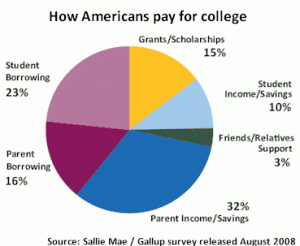529 Savings Plans: 101
/Are you a parent, guardian, aunt, uncle, godparent, grandparent…or anyone who cares about the future of a young person? If so, this post is for you! As you know, the cost of college and higher education is skyrocketing. Simultaneously, the student loan market is growing drastically and many fear its reaching bubble territory. All of these factors do not paint a rosy picture if you have a young one that you would like to attend college one day. The thought of having to pay $100,000 per year of college plus an arm and a leg, scares most people. (I happen to like both of my legs)

I cringe every time I hear the details of the horrendous “financial aid” packages that schools currently offer. I think they are better labeled as financial disasters. With the job market becoming increasingly more competitive, having a bachelors degree is no longer enough to set you apart. This means students will increasingly need to obtain advanced degrees and in some fields more than one advanced degree. That ultimately amounts to more potential educational related debt. (The other option is to start a billion dollar business in your dorm room or basement, but this isn’t a post about entrepreneurship) For many, college is a simply a financial burden and stress. In 2003-04 the average cost of attending a private institution was $25,700. In 2008-09 the number increased to $29,000! (According to the U.S Department of Education)

Given the shift in the economics of higher education it’s time that we change the conversation on financing education. Previous generations focused on financial aid and debt to fund their educations with the idea that the degrees would “pay for itself” over time in regards to higher earnings and better employment opportunities. This train of thought is no longer a fool proof method or guaranteed. So the conversation needs to shift to adequately saving for college expenses so that the next generation can afford the college of their dreams without breaking the bank.

How Can I Save for College?
Allow me to introduce you to a 529 Savings Plan. This qualified tuition plan, created by the IRS, has appealing tax benefits and is offered in all 50 states. There are two types of plans: pre-paid tuition plans and college savings plans. (Note: not all states offer both options)
In short, 529 Savings Plans allow you to save for college through investing. What’s better? The earnings from this account aren’t taxed by the federal government. (And there can be tax advantages on the state level as well) The proceeds from the plans can be used for all qualified educational expenses. (Each plan specifies what those qualified expenses are.)
A 529 Pre-paid tuition plan allows you to lock in tomorrow’s tuition at today’s rate. Pretty nice, huh? If you purchase a year of college at today’s rate, you can use the proceeds to pay for a year of college twenty years from now, even if the price has increased drastically.
You can invest in a 529 Plan in any state and can also own 529 Plans in multiple states. Most state plans offer tax incentives for residents that open plans within their home state.
As of 2012, there was over $180 billion saved in 529 plans and the average account had $17,000. Although $17,000 is far below what is needed for college expenses, every dollar helps!
How to Get Started
Start by researching the 529 Plan in your home state or state of permanent residence. Review what the plan has to offer and what the investment options are, account minimums, fees, and qualified educational expenses requirements. Fees are very important. Look for plans that offer fees less than 1%. However, be mindful of the tax incentives and advantages of investing in a 529 Plan in your state.
What to Invest In
I recommend a targeted, age based strategy that becomes more conservative closer to the time that the funds will be needed. (Very similar to saving for retirement) The younger the beneficiary of the 529 Plan the more risky the portfolio should be. For a newborn or child on the way, I recommend starting with allocation of 90% stocks and 10% bonds. As the beneficiary of the account gets older the fixed income allocation should increase. As the beneficiary readies for college the portfolio should then include stocks, bonds, and a money market fund (cash). This allows you to protect the earnings you have acquired after all the years of diligent investing. By age 17, I recommend the allocation resemble 90% money market fund, 7% fixed income, and 3% stocks.
However, do note there is a limit to the number of investment changes you can make within your 529 Plan on annual basis. Exceeding this amount often results in a penalty.

Turbo Boost Your 529 Plan
Companies are beginning to offer matches for their employees 529 Savings Plans similar to matching they currently offer for 401k plans. Inquire within your Human Resources or Benefits departments to see if your employer offers such an incentive!
Another option – 13 states currently offer 529 Savings matching grants. The grants are usually state specific and you must permanently reside in the state that offers it. The grants must be applied for and there are income guidelines. Some states offer a $1 for $1 for match while other states just offer lump sums or percentages of what you have saved.
Here is a list of states that offer grants or matches for 529 Plans: (Source: Black Enterprise 2013: April/May issue)
- Arkansas
- Colorado
- Florida
- Kansas
- Louisiana
- Maine
- Missouri
- Nevada
- North Dakota
- Rhode Island
- Texas
- Utah
- West Virginia
Get on the right path for college saving today. For more detailed information on 529 Plans check out this great article which provides a thorough overview of the ins and outs.
About the Author: Femi Faoye is the Co-Founder and Chief Executive Officer of D.R.E.A.M. He's also the Founder of Millennial Capital Management, an investment management firm based in New York City. He’s a staunch and passionate financial literacy education advocate.
Disclaimer:
Notwithstanding any language to the contrary, the views expressed in this post reflect those of the author and are solely theirs and do not reflect the views of Developing Responsible Economically Advanced Model-Citizens, Incorporated or any affiliates. Opinions are based upon information the author deems reliable but Developing Responsible Economically Advanced Model-Citizens, Incorporated does not warrant its completeness or accuracy and should not be relied upon as such. Neither the author nor Developing Responsible Economically Advanced Model-Citizens, Incorporated guarantees any specific outcome or profit from recommendations presented and you should be aware that losses may occur following any strategy or investment discussed. This material does not take into account your particular investment objectives, financial situation or needs. Before acting on information in this post you should consider whether it is suitable for your particular circumstances and strongly consider seeking advice from your own financial or investment adviser.
The contents of this post cannot be redistributed without the explicit written consent of the author and Developing Responsible Economically Advanced Model-Citizens, Inc. All images in this post owned by Developing Responsible Economically Advanced Model-Citizens, Inc. may not be used in any advertising, publicity, or otherwise to indicate members' sponsorship or affiliation with any product or service without the prior express written consent of Developing Responsible Economically Advanced Model-Citizens, Inc. All other images presented not owned by Developing Responsible Economically Advanced Model-Citizens, Inc. are the property of the author, respective company, or photographer. The rights to the images and likeness represented are under explicit ownership of the person(s) aforementioned.
